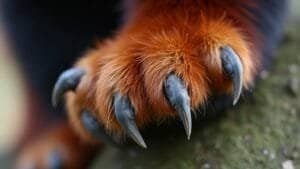How big is a red panda compared to other small mammals? It’s a question many animal lovers ask—and the answer might surprise you. Red pandas are more than just cute, tree-dwelling animals.
With an average length of 36 to 43 inches including the tail and weighing between 8 and 17 pounds, these creatures are larger than many small mammals like shrews, hamsters, or treeshrews.
In this article, we’ll explore the red panda’s exact size in inches and pounds, how it compares to animals like domestic cats and small-clawed otters, and where it ranks among Asia’s smaller mammals. You’ll also learn what makes its body shape and adaptations unique for life in the trees.
Average Size of a Red Panda in Inches and Pounds

Red pandas may appear small and fluffy, but their size might catch you off guard if you’re expecting something squirrel-sized. Despite being categorized among the world’s smaller mammals, red pandas are solidly built with a surprising length and weight.
In fact, when measured from head to tail, they’re longer than many domestic cats. Their size plays an important role in how they move through the treetops and survive in cool mountain environments.
But exactly how big are they? Let’s break down their measurements in clear numbers—and see how they stack up against other creatures their size.
How Long Is a Red Panda Including Its Tail?
One of the most striking features of the red panda is its long, bushy tail. It serves multiple purposes—from helping them balance on tree branches to wrapping around their bodies like a blanket in cold weather. But just how much does that tail add to their total length?
An adult red panda typically has a head-and-body length of 20 to 25 inches (about 51 to 63.5 cm). That’s already longer than most rodents or small carnivores.
The tail adds another 11 to 19 inches (roughly 28 to 48.5 cm), which means a red panda’s total body length from nose to tail tip ranges between 36 to 43 inches. That’s about as long as a standard baseball bat—or even longer.
What makes their tail unique isn’t just its length, but its thickness and use. While many small mammals have short, slim tails used for balance or steering, the red panda’s tail is heavily furred and ringed, which adds both insulation and camouflage.
Have you ever seen photos of red pandas curled up like a donut with their tail covering their nose? That’s one of their cold-weather survival tricks.
If you’re curious about exact measurements and visual references, this Wikipedia chart on red panda morphology includes scientific measurement data that goes deeper into specifics.
What Is the Average Adult Weight of a Red Panda?
Weight is just as important as length when evaluating an animal’s size—and red pandas can be deceptively heavy for their appearance. While they may look soft and fluffy, their dense bodies are built for climbing, cold, and foraging.
Most adult red pandas weigh between 8 and 17 pounds (about 3.6 to 7.7 kg). Some female red pandas might fall on the lighter end, around 6 to 10 pounds, while larger males often reach 10 to 14 pounds, with the heaviest individuals going slightly beyond that range.
To put this in perspective, a red panda weighs about the same as a medium-sized house cat, though it’s shaped quite differently. Instead of having a short, compact form, red pandas have elongated bodies, strong legs, and thick fur that adds to their bulk.
Their weight helps stabilize them as they climb trees, especially when navigating thin branches or reaching for leaves and bamboo.
This weight range makes them heavier than animals like civets or small-clawed otters in many cases. And definitely much heavier than squirrels, shrews, or treeshrews. If you’re imagining something you could cradle like a guinea pig, think again—a red panda feels more like a hefty loaf of bread with claws and a long tail.
Want more detail on how red panda weight compares across subspecies and locations? The Smithsonian’s red panda profile breaks it down by sex and age group, offering great data for deeper exploration.
Comparing Red Panda Size to Other Small Mammals

Red pandas are often described as “small mammals,” but that label can be a bit misleading without context.
When you place them next to other creatures commonly grouped in that category—like domestic cats, civets, or small-clawed otters—the differences in size and build become much clearer. Understanding how a red panda stacks up next to these animals helps us better grasp its place in the animal kingdom.
So, just how does this bamboo-loving climber compare to the rest? Let’s dive into the details.
How Does a Red Panda Compare to a Domestic Cat?
At first glance, a red panda and a domestic cat might seem similar in size—and in many ways, they are. But the red panda has a few physical traits that make it a bit bulkier and longer overall.
The average house cat weighs between 8 and 10 pounds and measures about 18 inches from nose to the base of its tail. Add the tail, and most cats reach a total length of 30 to 36 inches.
Red pandas, in contrast, weigh between 8 and 17 pounds, making them generally heavier than most cats. And when you include their tail, they reach a total length of 36 to 43 inches—up to 7 inches longer than many cats.
The difference doesn’t stop at numbers. Red pandas have thick limbs, a bushier tail, and a body built for gripping tree branches, unlike cats, which are more agile sprinters and climbers. Their tail alone—fluffy and ringed—adds a visual bulk that makes them appear even bigger than their weight suggests.
According to the Red Panda Network, these adaptations aren’t just for show. That extra size and fur help red pandas conserve heat in their chilly Himalayan habitats, whereas domestic cats are adapted to a wide range of indoor or warmer outdoor environments.
So yes, red pandas and cats can weigh about the same, but the red panda’s longer body, chunkier tail, and climbing adaptations give it a bigger, more solid presence.
Is a Red Panda Bigger Than a Small-Clawed Otter?
This is a closer comparison than with house cats. The Asian small-clawed otter, like the red panda, is a small carnivore found across parts of Asia. But despite its similar size at first glance, the red panda generally comes out on top in both weight and length.
An adult small-clawed otter weighs about 6 to 12 pounds and measures 16 to 25 inches in body length, with a tail of 10 to 14 inches. That gives the otter a total length of up to 39 inches. Red pandas, meanwhile, range from 8 to 17 pounds and measure 36 to 43 inches total. Not only are red pandas heavier, but they are also longer in most cases.
The otter’s build is sleeker and more flexible for swimming, while the red panda’s sturdy limbs and broad paws are better suited for life in the trees. Otters are semi-aquatic and more social, often living in groups, while red pandas are arboreal and solitary, meaning they rely more on stealth and balance than speed or coordination.
If you’re comparing these two side by side, you’ll notice the red panda has a fluffier, rounder appearance, largely due to its thick fur and broader body. The otter looks leaner and sleeker, even though their weights can sometimes overlap.
Are Red Pandas Larger Than Tree Shrews and Civets?
Absolutely—and by a large margin.
Let’s start with the common treeshrew (Tupaia glis). These small mammals weigh around 0.4 pounds and measure only 5 to 8 inches in body length, with tails of roughly 5 to 8 inches. That puts their total size under 16 inches. Red pandas can weigh over 40 times more and are nearly three times longer. There’s no real overlap.
Next up: the Asian palm civet (Paradoxurus hermaphroditus). These mammals are closer in size to red pandas but still smaller on average. A civet generally weighs 4 to 11 pounds and measures 16.5 to 28 inches in body length, with a tail about 13 to 26 inches long. That gives a total length range from 29 to 54 inches, overlapping slightly with red pandas in length—but rarely in weight. Red pandas, weighing up to 17 pounds, are noticeably heavier and more solidly built.
Unlike red pandas, civets and treeshrews are both ground-foraging animals that also climb. But neither is as specialized for arboreal life. Red pandas have a flexible ankle joint and a “false thumb” that helps them grip branches—something civets and treeshrews don’t have.
If you’re wondering about their ecological niches and how that affects their size and build, the Red Panda Network provides helpful comparisons between red pandas and other forest mammals, including civets.
Size Rankings Among Small Asian Mammals

Calling red pandas “small mammals” might be technically correct, but that category includes everything from hamsters to otters—and red pandas sit at the upper edge of that scale.
To really understand where they fit in the animal size spectrum, we need to compare them directly to other mammals found across Asia. Whether you’re curious about their weight class or total body length, this section breaks down where the red panda ranks among its peers.
Where Do Red Pandas Rank by Weight Among Asian Mammals?
Let’s look at the numbers. The red panda typically weighs between 8 and 17 pounds. That’s significantly heavier than small rodents like the Chinese striped hamster (which weighs less than 0.2 pounds) or the Asian house shrew (around 0.04 to 0.3 pounds). Even tree shrews and chevrotains don’t come close, weighing in between 0.4 and 4.4 pounds.
Next to more sizable creatures like Asian palm civets or small-clawed otters, red pandas are still heavier on average. Civets weigh 4.4 to 11 pounds, while small-clawed otters typically weigh between 6 to 12 pounds. This positions red pandas just above the median range of these mid-sized forest mammals.
Even more interesting is how red pandas rank against pangolins. While the Sunda pangolin can reach weights of up to 22 pounds, it tends to stay around the 10–15 pound range, similar to heavier red pandas. However, pangolins have a more armored body type and less flexibility.
To get a clear view of the rankings, a vertical chart of 10 Asian mammals by weight shows that red pandas rank #7 out of 10, making them larger than many, but smaller than a few semi-mid-sized species like raccoon dogs or larger pangolins. This Wikipedia red panda overview includes a comparison table showing these weight tiers across species.
So, while the red panda isn’t massive, it certainly outpaces most animals labeled “small mammals,” making it one of the bigger members of that broad group.
How Does a Red Panda Compare to the Sunda Pangolin?
On paper, red pandas and Sunda pangolins might seem similar—they’re both quiet, solitary animals from Asia, roughly the size of a house cat. But a closer look at their measurements shows some key differences in size and structure.
The Sunda pangolin can reach a body length of up to 25.6 inches and a tail length of 22 inches, giving it a total length of nearly 48 inches. In comparison, a red panda has a body length of 20 to 25 inches and a tail of 11 to 19 inches, totaling around 36 to 43 inches. So pangolins can be a little longer overall, depending on the individual.
In terms of weight, both species can overlap. Red pandas range from 8 to 17 pounds, while Sunda pangolins typically weigh between 10 and 22 pounds. This means pangolins can be heavier than most red pandas, especially older individuals.
But what sets them apart is their physical build. Red pandas are fluffy, broad-footed climbers with gripping paws and semi-retractable claws. Pangolins, on the other hand, are scaled, armored insect-eaters with powerful digging limbs but no climbing adaptations. Pangolins walk awkwardly on their knuckles and are more ground-based, while red pandas live high in the trees.
Also, red pandas are far more flexible and agile, using their long tail for balance in the canopy. Pangolins, though longer in some cases, lack this tail function and have a more rigid body due to their keratin armor.
This size and structural comparison makes clear that while they may seem similar in length or weight at times, the red panda is built for climbing, whereas the pangolin is built for protection and burrowing. The Red Panda Network goes into more detail about how these body types suit different environments, especially in Southeast Asian forests.













